#Saint Brigid of Kildare
Text
SAINT OF THE DAY (February 1)

On February 1, Catholics in Ireland and elsewhere will honor Saint Brigid of Kildare, a monastic foundress who is – together with Saint Patrick and Saint Columcille – one of the country’s three patron saints.
St. Brigid directly influenced several other future saints of Ireland, and her many religious communities helped to secure the country's conversion from paganism to the Catholic faith.
She is traditionally associated with the Cross of St. Brigid, a form of the cross made from reeds or straw that is placed in homes for blessing and protection.
Some Eastern Catholics and Eastern Orthodox Christians also celebrate her feast.
St. Brigid has been profiled many times by both ancient and modern writers.
However, it is notoriously hard to establish the historical details of her life, and the various accounts make many conflicting claims.
According to one of the more credible biographies of Brigid — Hugh de Blacam's essay in “The Saints of Ireland” — on which the following account is based, most historians place her birth around the year 450, near the end of Saint Patrick's evangelistic mission.
Brigid was born out of wedlock, the daughter of a pagan chieftain named Dubthach and a Christian slave woman named Broicsech.
The chieftain sold the child's pregnant mother to a new master but contracted for Brigid to be returned to him eventually.
According to de Blacam, the child was probably baptized as an infant and raised as a Catholic by her mother.
Thus, she was well-formed in the faith before leaving Broicsech's slave-quarters at around age 10 to live with Dubthach and his wife.
Within the new circumstances of the chieftain's household, Brigid's faith found expression in feats of charity.
From the abundance of her father's food and possessions, she gave generously to the poor.
Dubthach became enraged, threatening to sell Brigid, who was not recognized as a full family member but worked as a household servant to the King of Leinster.
But the Christian king understood Brigid's acts of charity and convinced Dubthach to grant his daughter her freedom.
Released from servitude, Brigid was expected to marry. But she had other plans, which involved serving God in consecrated life.
She even disfigured her own face, marring her beauty in order to dissuade suitors.
Understanding he could not change her mind, Dubthach granted Brigid permission to pursue her plan and material means by which to do so.
Thus did a pagan nobleman, through this gift to his illegitimate daughter, play an unintentional but immense part in God's plan for Ireland.
While consecrated religious life was part of the Irish Church before Brigid's time, it had not yet developed the systematic character seen in other parts of the Christian world by the fifth century.
Among women, vows of celibacy were often lived out in an impromptu manner, in the circumstances of everyday life or with the aid of particular benefactors.
Brigid, with an initial group of seven companions, is credited with organizing communal consecrated religious life for women in Ireland.
Bishop Mel of Ardagh – St. Patrick's nephew, and later “St. Mel” – accepted Brigid's profession as a nun.
According to tradition, the disfigurement she had inflicted on her face disappeared that day, and her beauty returned.
St. Mel went on to serve as a mentor to the group during their time at Ardagh.
Around the time of his death in 488, Brigid's community got an offer to resettle.
Their destination is known today as Kildare (“Church of the Oak”), after the main monastery she founded there.
Brigid's life as a nun was rooted in prayer, but it also involved substantial manual labor: cloth-making, dairy farming, and raising sheep.
In Ireland, as in many other regions of the Christian world, this communal combination of work and prayer attracted vast numbers of people during the sixth century.
Kildare, however, was unique as the only known Irish “double monastery” — it included a separately-housed men's community, led by the bishop Saint Conleth.
From this main monastery, Brigid's movement branched out to encompass a large portion of Ireland.
It is not clear just how large, but it is evident that Brigid traveled widely throughout the island, founding new houses and building up a uniquely Irish form of monasticism.
When she was not traveling, many pilgrims – including prominent clergy and some future saints – made their way to Kildare, seeking the advice of the abbess.
Under Brigid's leadership, Kildare played a major role in the successful Christianization of Ireland.
The abbess' influence was felt in the subsequent era of the Irish Church, a time when the country became known for its many monasteries and their intellectual achievements.
St. Brigid of Kildare died around 525.
She is said to have received the last sacraments from a priest, Saint Ninnidh, whose vocation she had encouraged.
Veneration of Brigid grew in the centuries after her death and spread outside of Ireland through the work of the country's monastic missionaries.
12 notes
·
View notes
Text

Made this to fight off art block and I’m kinda just done with it but also not that satisfied because what is that composition.. this mostly features deities associated with alcohol, though some aren’t. It was kinda just me having fun with things and working on more designs.
I’ve grown up around alcohol in a very healthy sense compared to most others who would say that. My family drinks a fair amount, but never to a point where that hinders any of our relationships and helps me learn about safe drinking for when I’m legally allowed to do it. So even though I’m not legally allowed to consume alcohol characters and representations associated with it are extremely interesting to me.
anyways, this started because I was thinking about the issue of Greco Roman syncretism specifically in regards to Dionysos, Bacchus and Liber Pater. Dionysos is Bacchus, it’s one of his most common epithets. Liber Pater is syncretic in Roman sources and very similar, so it isn’t off putting to read about Dionysos just given his name. But it’s not exactly correct to call them the same because we also have recorded sources against treating them as syncretic. So I got thinking, and I wanted to make a piece of wine deities chilling. Then it got bigger, more alcohol deities (and St. Brigid of Kildare because why not?) we’re added, Bes is also there because I think he’s interesting, and so my art block was very unhelpful. But it’s something to get back into the swing of things so!
featuring Liber Pater (I gave him hair based on green grapes and white wine and tried to capture a slightly queerer vibe of my local Italian fuckboys) Dionysos (why wouldn’t I?), Nephthys, Silenus and Bes because old people like to party too, a depiction of Jesus based on old artworks that would 100% get me kicked out of a church if they knew, St. Brigid of Kildare because we Stan a Queen who punished selfish rich people and provides safe abortions (which yes that is an out of context joke but lmao it’s based on something also she likely originates from the pagan goddess so 💅🏼 Rip catholic purists), Sucellus, and Ninkasi, holding a glass beer cup based on some of the first in Mesopotamia but I managed to fuck it up.
it’s not perfect. I’m not proud. But eh
#art#failed art kinda#ramblings#mythology#greek mythology#roman mythology#egyptian mythology#christian mythology#celtic mythology#mesopotamian mythology#dionysus#dionysos#Bacchus#liber pater#traditional art#nephthys#bes#silenus#jesus christ#Saint Brigid of kildare#Sucellus#Ninkasi#jesus was a heretical Jew fight me on it I dare you#This also gives anarchist if you dig deep haha#Markers
15 notes
·
View notes
Text

“I should like a great lake of beer for the King of Kings.
I should like the angels of Heaven to be drinking it through time eternal.
I should like excellent meats of belief and pure piety.
I should like the men of Heaven at my house.
I should like barrels of peace at their disposal.
I should like for them cellars of mercy.
I should like cheerfulness to be their drinking.
I should like Jesus to be there among them.
I should like the three Marys of illustrious renown to be with us.
I should like the people of Heaven, the poor, to be gathered around from all parts.”
Blessed feast day of Saint Brigid of Kildare! ☘️
5 notes
·
View notes
Text
2/1/23
Through the intercession of holy women, let us pray for the Church in these words: Be mindful of Your Church, Lord.
Through all the women martyrs who conquered bodily death by their courage,
—strengthen Your Church in the hour of trial. Be mindful...
Through married women who have advanced in grace by holy matrimony,
—make the apostolic mission of Your Church fruitful. Be mindful...
Through widows who eased their loneliness and sanctified it by prayer and hospitality,
—help Your Church reveal the mystery of Your love to the world. Be mindful...
Through mothers who have borne children for the kingdom of God and the human community,
—help Your Church bring all men to a rebirth in life and salvation. Be mindful...
Through all Your holy women who have been worthy to contemplate the light of Your countenance,
—let the deceased members of Your Church exult in that same vision forever. Be mindful...
Our Father...
Let Us Pray:
Merciful God,
origin and reward of all charity,
You called Saint Brigid to teach the new commandment of love
through her life of hospitality and her care of the needy;
give to Your people, by her intercession,
a generous spirit,
so that, with hearts made pure,
we may show Your love to all.
Through our Lord Jesus Christ, your Son,
who lives and reigns with you and the Holy Spirit,
God, for ever and ever.
Amen.
1 note
·
View note
Text

Happy feast day, St. Brigid!
#feast day#st. brigid of kildare#catholic#irish#saint#art print#art#catholic art#ducks#baby cow#calf#ireland#green#baby duckies#st. brigid's cross#art sale
31 notes
·
View notes
Text

Saint Brigid's Cathedral, Kildare Town, Ireland and the round tower and high cross on a sunny day.
#ireland#vsco#landscape#vscocam#irish#photographers on tumblr#photography#travel#kildare#gaa#squires gannon#panorama#panoramic ireland#county kildare#irish buildings#heritage#saint brigid#saint brigid's cathedral#round tower#sam maguire cup
42 notes
·
View notes
Text
The Feast Day of St Brigid | Imbolc – The traditional first day of Spring in Ireland
St Brigid of Kildare or Brigid of Ireland (c. 451-525) is one of Ireland’s patron saints along with Saints Patrick and Colm Cille. Her feast day is 1 February or Imbolc, the traditional first day of spring in Ireland. She is believed to have been an Irish Christian nun, abbess, and founder of several convents. The feast day of of the patron saint will be celebrated with a state holiday starting…

View On WordPress
#Co. Kildare#Feast Day of St Brigid#Imbolc#Patron Saint of Ireland#Sculptor Annette McCormack#St Bridgid’s Well#Statue of St Brigid
17 notes
·
View notes
Text


About St Brigid of Ireland
About St Arnold Janssen
Losers' Bracket Round 1
#st brigid#st arnold janssen#catholic saint tournament#polls#tumblr bracket#tumblr tournament#christianity#theology#catholic saints#tumblr polls#catholicism#catholic#st brigid of ireland#st brigid of kildare
17 notes
·
View notes
Text
9. Of the Pregnant Woman Blessed and Spared the Birth-Pangs
"1. With a strength of faith most powerful and ineffable, [Brigit] blessed a woman who, after a vow of virginity, had lapsed through weakness into youthful concupiscence, as a result of which her womb had begun to swell with pregnancy. In consequence, what had been conceived in the womb disappeared and she restored her to health and to penitence without childbirth or pain.
2. And, in accordance with the saying 'All things are possible to those who believe', she went on working countless miracles every day without ever proving anything impossible."
-Cogitosus, Life of Saint Brigit (translated by Sean Connolly and J.M. Picard, 1987)
This translation is in my personal files and I can send a copy to you upon request. If you want to thank me, consider a donation to The Brigid Alliance.
#Brighid#Brigid#Brigit#Bríd#Cogitosus#Cogitosus's Life of St. Brigit#Vita sancta Brigide#abortion#abortion miracles#protectors of women#justice goddesses#healing goddesses#Brigid of Kildare#Brigid of Ireland#Irish saints#Irish goddesses#Brighidine paganism#gabhaim molta Bríde#thank you Lady
11 notes
·
View notes
Text

St Brigid's Holy Well Kildare, County Kildare, Ireland.
In Irish mythology Brigid was the Celtic goddess of fire, poetry, unity, childbirth and healing. She was the daughter of Dagda a High King of the Tua Dé Danann. Sacred wells were always places of pilgrimage to the Celts. They would dip a clootie (piece of rag) in the well, wash their wound and then tie the clootie to a tree. generally a Whitethorn or Ash tree, as an offering to the spirit of the well. It seems only natural that these traditions would be carried forward into modern times in the form of Saint Brigid. Today's pilgrimages to holy wells usually take place on the Saints feast day or Pattern or Patron days.
6 notes
·
View notes
Text

On February 1, Catholics in Ireland and elsewhere will honor Saint Brigid of Kildare, a monastic foundress who is – together with Saint Patrick and Saint Columcille – one of the country’s three patron saints.
St. Brigid directly influenced several other future saints of Ireland, and her many religious communities helped to secure the country's conversion from paganism to the Catholic faith.
She is traditionally associated with the Cross of St. Brigid, a form of the cross made from reeds or straw that is placed in homes for blessing and protection.
Some Eastern Catholics and Eastern Orthodox Christians also celebrate her feast.
St. Brigid has been profiled many times by both ancient and modern writers, but it is notoriously hard to establish the historical details of her life, and the various accounts make many conflicting claims.
According to one of the more credible biographies of Brigid, Hugh de Blacam's essay in “The Saints of Ireland,” on which the following account is based – most historians place her birth around the year 450, near the end of Saint Patrick's evangelistic mission.
Brigid was born out of wedlock, the daughter of a pagan chieftain named Dubthach and a Christian slave woman named Broicsech.
The chieftain sold the child's pregnant mother to a new master but contracted for Brigid to be returned to him eventually.
According to de Blacam, the child was probably baptized as an infant and raised as a Catholic by her mother.
Thus, she was well-formed in the faith before leaving Broicsech's slave-quarters, at around age 10, to live with Dubthach and his wife.
Within the new circumstances of the chieftain's household, Brigid's faith found expression in feats of charity.
From the abundance of her father's food and possessions, she gave generously to the poor.
Dubthach became enraged, threatening to sell Brigid – who was not recognized as a full family member but worked as a household servant – to the King of Leinster.
But the Christian king understood Brigid's acts of charity and convinced Dubthach to grant his daughter her freedom.
Released from servitude, Brigid was expected to marry. But she had other plans, which involved serving God in consecrated life.
She even disfigured her own face, marring her beauty in order to dissuade suitors.
Understanding he could not change her mind, Dubthach granted Brigid permission to pursue her plan and material means by which to do so.
Thus did a pagan nobleman, through this gift to his illegitimate daughter, play an unintentional but immense part in God's plan for Ireland.
While consecrated religious life was part of the Irish Church before Brigid's time, it had not yet developed the systematic character seen in other parts of the Christian world by the fifth century.
Among women, vows of celibacy were often lived out in an impromptu manner, in the circumstances of everyday life or with the aid of particular benefactors.
Brigid, with an initial group of seven companions, is credited with organizing communal consecrated religious life for women in Ireland.
Bishop Mel of Ardagh – St. Patrick's nephew and later “St. Mel” – accepted Brigid's profession as a nun.
According to tradition, the disfigurement she had inflicted on her face disappeared that day and her beauty returned.
St. Mel went on to serve as a mentor to the group during their time at Ardagh.
Around the time of his death in 488, Brigid's community got an offer to resettle. Their destination is known today as Kildare (“Church of the Oak”), after the main monastery she founded there.
Brigid's life as a nun was rooted in prayer, but it also involved substantial manual labor: cloth-making, dairy farming, and raising sheep.
In Ireland, as in many other regions of the Christian world, this communal combination of work and prayer attracted vast numbers of people during the sixth century.
Kildare, however, was unique as the only known Irish “double monastery”: it included a separately-housed men's community led by the bishop Saint Conleth.
From this main monastery, Brigid's movement branched out to encompass a large portion of Ireland.
It is not clear just how large, but it is evident that Brigid traveled widely throughout the island, founding new houses and building up a uniquely Irish form of monasticism.
When she was not traveling, many pilgrims – including prominent clergy and some future saints – made their way to Kildare, seeking the advice of the abbess.
Under Brigid's leadership, Kildare played a major role in the successful Christianization of Ireland.
The abbess' influence was felt in the subsequent era of the Irish Church, a time when the country became known for its many monasteries and their intellectual achievements.
St. Brigid of Kildare died around 525.
She is said to have received the last sacraments from a priest, Saint Ninnidh, whose vocation she had encouraged.
Veneration of Brigid grew in the centuries after her death and spread outside of Ireland through the work of the country's monastic missionaries.
8 notes
·
View notes
Text
New Holiday Celebrates St. Brigid of Ireland
New Holiday Officially Recognized in Ireland
A new holiday in Ireland celebrates St. Brigid of Kildare, one of Ireland’s oldest figures.
St. Brigid of Kildare, according to story, was a younger contemporary of the better-known St. Patrick, now the Catholic patron saint of Ireland, healing, blacksmithing, and dairy farming. To others, she’s older, an ancient goddess of the same name and attributes.
For both, this year Ireland is making St.…
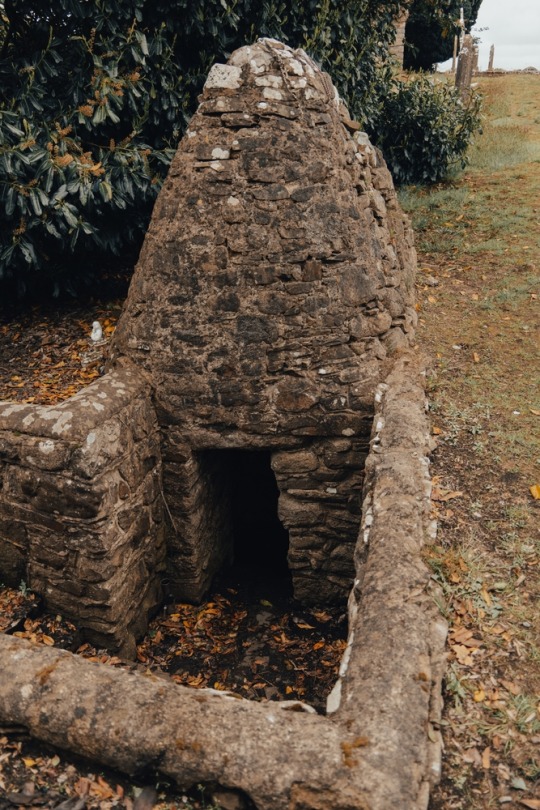
View On WordPress
0 notes
Text

Bridget, Bright Goddess of the Gael
Talon Abraxas
Brigid was a goddess of the Tuatha Dé Danann. She was a daughter of the chief of the gods, The Dagda, and was known as a goddess of healers, poets, smiths, childbirth and inspiration. Her name means "exalted one". This article by Branfionn NicGrioghair explores the story of Brigid and the later Christian Saint, St. Brigid, who is still honoured to this day, especially in Faughart, her birthplace, and Kildare, where she founded a monastery.
Brigid is the Daughter of the Dagda, one of the more universal deities of the pagan Gaelic world. She is known as the Goddess of Healers, Poets, Smiths, Childbirth and Inspiration; Goddess of Fire and Hearth and a patron of warfare or Briga. Her soldiers were called Brigands. Her name means "Exalted One." She is also known as Brigantia, Brid, Bride, Briginda, Brigdu, and Brigit. She is said to lean over every cradle. The lore and customs have continued to this day regarding Brighid, more vividly than all the other Gaelic deities combined.
In the middle ages, Brigid is in many stories. In one she is the wife of Bres, the half-Fomorian ruler of the Tuatha Dé Danann. Their son, Ruadan, wounded the smith god Giobhniu at the second battle of Magh Tuireadh but he himself was slain in the combat. Brigid then went to the battlefield to mourn her son. This was said to be the first caoine (keening), or lament, heard in Ireland. Until recent time, it was a tradition to hire women to caoine at every graveside. In another story, Brighid was the wife of Tuireann and had three sons: Brian, Iuchar and Ircharba. In the tale, The Sons of Tuirean, these three killed the god Cian, father of Lugh Lámhfhada when he was in the form of a pig.
She was transformed by the Church of St. Brigid into St. Brigid about 453 C.E. Saint Brighid is known as the patroness of farm work and cattle, and protector of the household from fire and calamity. To this day, one of her most common names in Gaelic is Muime Chriosd, "Foster-Mother of Christ." St. Brigid was said to be the daughter of Dubthach, a Druid who brought her from Ireland to be raised on the Isle of Iona, sometimes called "The Druid's Isle."
By Branfionn NicGrioghair
56 notes
·
View notes
Text
NAKSHATRAS AS GODDESSES
3/27
🔪KRITTIKA🔥
DISCLAIMER: This is based solely on my research and the patterns that I saw. I can't promise that I'm gonna be sure in all the coorelations, but I'm going to attribute each nakshatra a goddess that I think fits it the closest. If you're dissapointed, to make up for it, I'm going to list some other deities in the end that I think also fit the nakshatra. Don't come for me if you think I'm wrong, be respectful in the comments if you think so and have fun 🤍
This was easy and almost immidiate. The associations between this goddess and Krittika are so apparent I didn't hesitate for a second. Look out for other deities similar to her in the end.
Brigid
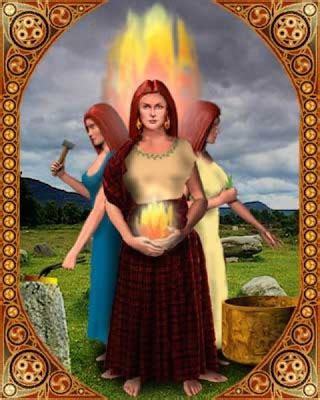
Pantheon: Celtic (Irish)
Name meaning: "the exalted one", "strength"
Associations: fire, spring, poetry and inspiration, healing and herbalism, smithcraft, agriculture, cattle and sheep.
Symbols: Brigid's cross, holy wells, eternal flame.
Brigid is one of the most highly- revered and widely worshipped Celtic goddesses. She'a triple goddess, representing the maiden, the mother and the crone. As a Maiden, she rules over poetry, music and ispiration. As a Mother, she's presiding over healing. As a Crone, she's the goddess of fire and smithcraft.
Frequently depicted with fiery red hair, she is no simple goddess, also ruling over waters and serenity. She's a protector of women and children, presiding over childbirth and motherhood. Also frequengly depicted with lambs and sheep (krittika's yoni animal) and swans. She's closely connected to agriculture and farm animals.
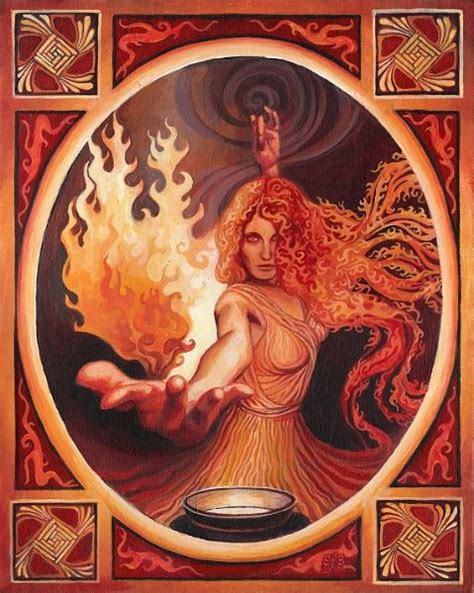
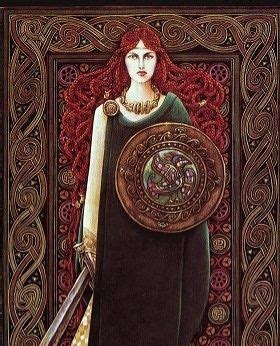
Brigid, also being connected to wells and rivers, has many landmarks in Ireland with a body of water. The most famous one is a well in Kildare, Ireland. Water from that well is said to have healing properties.
Her father was Dagda (good, great god), leader of the Irish tribe Tuatha Dé Danann ("people of goddess Danu"), which consisted of Irish deities who lived there before the ancestors of the modern Irish had arrived. Dagda was a wise man, an all-father and a Druid. Brigid married Bres, another member of that tribe and together they had three children. One of them, Ruadán, died and Brigid mourned him with profound and painful sadness. She's very devoted to protecting children and this might be a reason why.

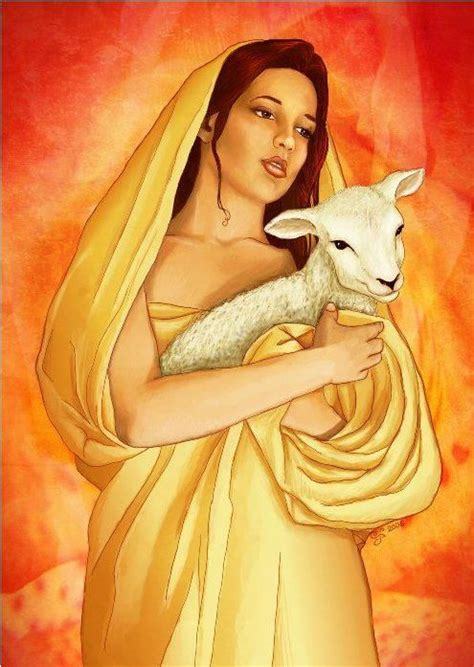
In honor of her, there's a sacred fire lit in Kildare and is guarded by the Sisters of St. Brigid. There has been a fire in Kildare since the time Brigid was worshipped. It has been put out several times, but has been re-lit and is still burning. This suggests that the worship of Brigid has endured as she she survived and was made a Catholic saint when Christianity came to Europe.

I want to talk about why I chose her for Krittika while comparing her to very similar goddesses.
First one is the Roman Vesta. Virgins were chosen to keep the fire of vesta burning and it was said that if even one of them gave their virginity, the fire would burn out. In those instances when fire burned out by itself, the poor Vestal Virgins were to blame. Vesta is also the Roman Equivalent of the Greek Hestia, both being goddesses of the hearth, fire and home.
Krittika is the nakshatra that burns impurities through being precise and cutting away all that is not nessecary, hence a sharp object and a flame being its symbols. Bridging the signs of Aries and Taurus, it's often fiery and passionate but also feminine and nurturing.
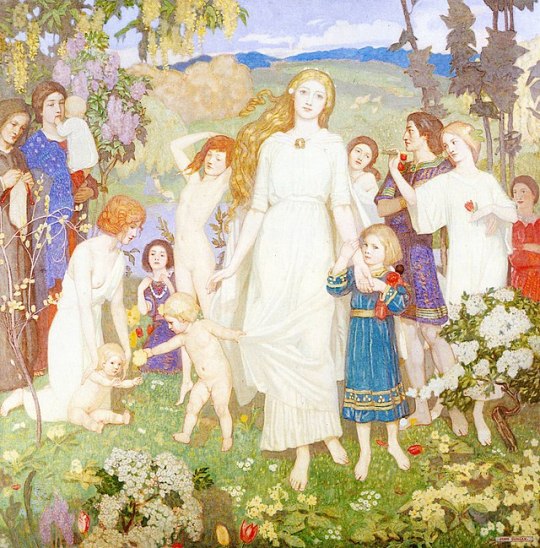
An Indian deity ruling over Krittika is Agni_ God of fire. An Indian goddess that is coorelated to Krittika (and also Purva Phalguni) is Tripura Sundari, meaning "the most beautiful in three worlds". This three world- triple goddess coorelation is apparent to me, besides the obvious fire associations, as well as nurturing, fertility and agriculture.
In the lunar mansion of Krittika, there's a constellation called the Pleiades, often called "the seven sisters". This is another confirmation of Krittika's very feminine nature, despite also representing the birth of the cosmic man and being very fiery and passionate in general.
Some other deities that I'd coorelate with Krittika:
Hestia- another virginal goddess of fire, also associated with home and hearth
Tripura Sundari- Indian goddess, "the most beautiful in the worlds"
Vesta- Roman goddess of fire and virgins
Bel- Celtic sun and fire god, also associated with healing, thunder and purification.
That's it! I hope you enjoyed reading about Brigid. This is a very condensed post but I said pretty much everything I wanted to say. I hope you understood Brigid's energy and made the coorelation between her and Krittika. If you're Krittika, even if you're not, COMMENT, like and reblog. Love u, take care ❤🔥
#krittika#krittika nakshatra#nakshatras#vedic astrology#astrology#astrology observations#vedic astrology observations#brigid#celtic mythology#irish mythology#ireland#celtic#goddess#goddess brigid
121 notes
·
View notes
Text

Saint Brigid of Ireland
451-525
Feast day: February 1
Patronage: Ireland
Saint Brigid was born in Ireland to a pagan chieftain and a Christian slave. She founded the Abbey of Kildare which was ruled by a double line of abbot-bishops and abbesses; thus the reason why she holds the crosier. Her school of art, learning, and spirituality at Kildare produced an illuminated manuscript praised as one of the finest examples of its kind. (It has been lost since the Reformation.) St. Brigid is known as the "Mary of the Gael" and holds the straw cross that people place in their homes for blessings and protection. She is buried with St. Patrick and St. Columba.
Prints, plaques & holy cards available for purchase here: (website)
81 notes
·
View notes
Text
Important Facts about Imbolg from an Irish Celtic Reconstructionist

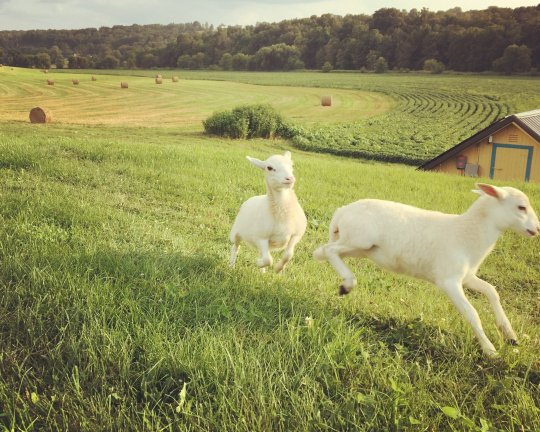

Spelling and Pronunciation
Imbolc, as it is often written, or Imbolg, as it is written in older texts is pronounced like Im-bolɤg, for only English speakers think of that ending g/c sound as being a back of the mouth guttural sound (similar to ‘ch’ in loch)
Dates
Most reconstructionists celebrate Imbolg on Jan 31- Feb 1, while others choose to observe it on the first day of the month by the Julian Calander (which currently is a difference of about 13 days), from sundown to sundown. However in the most “traditional” sense this festival has been linked to the first birthing of lambs.
Importance in the Mythos
Imbolg is not discussed extencively in the mythological texts of Ireland but a 10th century version of Tochmarc Emire names Imbolc and lists it as taking place “when the ewes are milked as spring’s beginning”
Celebration Traditions
These days Imbolg is deeply intertwined with the celebrations of St. Brigid’s day. This is obviously most likely because Brigid the Pre-Christian goddess was replaced in the hearts and minds of the Irish by her Saint iteration and as such her festival was also commandeered.
It is now most often associated with things like the healing springs of Ireland (which had sacred properties before Christianity and likely were part of the festival before it was Christianized), the hearth flame (though this is likely from Kildare’s St. Brigid’s cult more so than the Pre-Christian iteration of Brigid), Brigid’s crosses and dolls and Brigid “visiting” homes and birthing beds named after her. It is almost impossible to definitively say which if any of these practices may have grown out of the activities and practices of the Pre-Christian festival and which originated only with St. Brigid.
Art Credit @feyspeaker
#Imbolc#Imbolg#Irish#irish mythology#irish polytheism#irish paganism#celtic reconstructionism#celtic paganism#celtic mythology#celtic polytheism#goddess brigid#saint brigid#brigid#fire festival#blackcrowing#irish reconstructionist#irish reconstructionism
325 notes
·
View notes